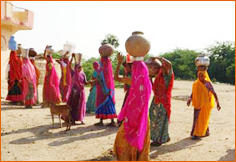| This involves the creation of artificial wetlands using aquatic plant root zone system to treat sewage waters upto tertiary levels for recycling to the irrigation and horticultural sector and possibly some industrial estates. |
|
|
 The system utilizes the roots of certain types of plants to provide sub-strates for the growth of bacteria, which utilizes the nutrients present in the effluents, and for the transfer of oxygen. The plants commonly employed are duckweed, water hyacinth, pennwort, etc. The plants have to be harvested regularly and about 20% to 25% plants should be removed at each harvest. These plants have a root system of rhizomes, containing thick hollow air passages, from which fine hair roots hang down. This root zone can support a very large population of aerobic microorganism, Bacteria, dominate the microbial population, which is expected to degrade most of the simpler organic materials i.e. those contributing to BOD. The fungi and actinomycetes, although fewer in number, have a wider range of hydrolytic activities and are expected to degrade many of the large molecules that contribute to the COD. The system utilizes the roots of certain types of plants to provide sub-strates for the growth of bacteria, which utilizes the nutrients present in the effluents, and for the transfer of oxygen. The plants commonly employed are duckweed, water hyacinth, pennwort, etc. The plants have to be harvested regularly and about 20% to 25% plants should be removed at each harvest. These plants have a root system of rhizomes, containing thick hollow air passages, from which fine hair roots hang down. This root zone can support a very large population of aerobic microorganism, Bacteria, dominate the microbial population, which is expected to degrade most of the simpler organic materials i.e. those contributing to BOD. The fungi and actinomycetes, although fewer in number, have a wider range of hydrolytic activities and are expected to degrade many of the large molecules that contribute to the COD. |
|
|
| The waste water encounters alternate aerobic and anaerobic microbial population which convert carbonaceous and to lesser extent nitrogenous and phosphatic, contaminants in the water to less polluting materials. Further microorganisms can form biofilms around lower stems, which can then trap particles suspended in the wastewater by absorption. |
|
|
| It is expected to achieve an effluent quality of 5-10 mg/l of suspended solids. |
|
|
| Goals Of Water Program By Paramhans Daati Ji Maharaj |
|
|
 In urban areas, rain water available from roof tops of buildings, paved and unpaved areas goes waste. This water can be recharged to aquifer and can be utilized gainfully at the time of need. The rain water harvesting system needs to be designed in a way that it does not occupy large space for collection and recharge system. A few techniques of roof top rain water harvesting in urban areas are described below. In urban areas, rain water available from roof tops of buildings, paved and unpaved areas goes waste. This water can be recharged to aquifer and can be utilized gainfully at the time of need. The rain water harvesting system needs to be designed in a way that it does not occupy large space for collection and recharge system. A few techniques of roof top rain water harvesting in urban areas are described below. |
|
|
 |
Imparting timely information regarding leakages, bursting of pipelines to Jal Board and eliciting quick response to ensure effective and efficient functioning of the water distribution system to all levels. |
|
|
 |
Educating all citizens of rural areas regarding water conservation methods and techniques to bring about greater water efficiency and thus bring about an effective increase in supply of filtered water. |
|
|
 |
Inculcating an awareness of the rapid depletion of ground water level and the need to harvest rainwater through simple rain water harvesting structures. |
|
|
| Components Of Water Program |
